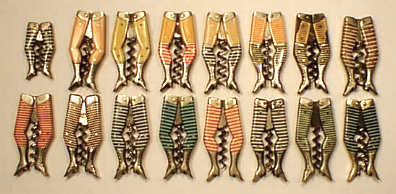|
||||||||||||
| Background | ||||||||||||
|
The
invention of celluloid was a major development in the world economy. This
invention gave a massive boost to the embryonic plastics industry.
The stimulus for the application of the invention was ironically the shortage of elephants whose ivory was needed for the manufacture of billiard and snooker balls. The game had become hugely popular in North America and Europe in the latter half of the 19th century. Celluloid would go on to be extensively used in the toy and novelty industries. It also gave its name to the film industry where it was used for filmstock until the 1950s. Cellulose is formed through a synthesis of nitrocellulose and camphor. |
||||||||||||
|
|
The true inventor of celluloid is a matter of debate. The American, John Wesley Hyatt (on the left), commercialised the plastic in 1869: however, the British chemist Alexander Parkes (on the right) was the first to synthesize celluloid in 1856. |
|
||||||||||
| Celluloid was widely used as a substitute for more expensive substances, such as ivory, amber, horn, whalebone, and tortoiseshell. It has been used for combs, brush handles, billiard balls, knife handles, buttons, and other useful objects. However due to high flammability, it has been largely superseded by newer plastics, with one notable exception. | ||||||||||||
| Applications | ||||||||||||
| One of the more bizarre yet highly indicative applications was in the manufacture of fashionable tools, such as penknives or pocketknives and corkscrews as shown on the right and dating to around 1910. |
|
|||||||||||
|
|
More
familiar to women would be the newly lifelike dolls that now could be
manufactured.
Celluloid allowed for a flexibility and brightness of pigmentation that had not been widely available before. The methods of manufacturing such dolls had largely been developed in Germany, but by the early 20th century Japanese engineers had become adept at the processes. |
|||||||||||
| Japan | ||||||||||||
|
The
development of the Japanese toy industry can largely be traced to the
trade in celluloid dolls and toys at the beginning of the 20th century.
Japan possessed the key raw material - Camphor - through her colonisation of Taiwan (Formosa) from 1895 to 1945: Formosan camphor at that time utterly dominated the world markets. Japanese engineers had also perfected the manufacturing processes necessary for the mass production of celluloid items. Another factor was to weigh in. In 1914 the European powers saw fit to devote all their energies on warfare. Industry was redirected at the war effort. However the demand from the expanded world markets for dolls and toys continued unabated, in particular from the richest country - the United States. Japan seized the opportunity and has never looked back. |
||||||||||||
|
||||||||||||



